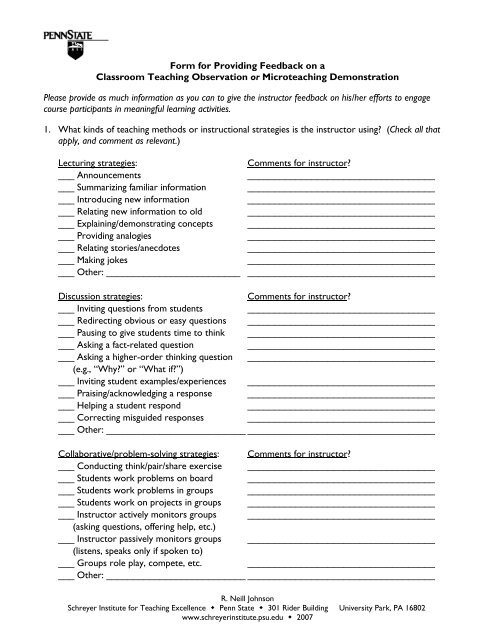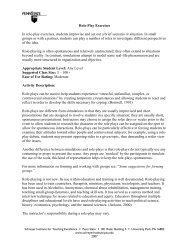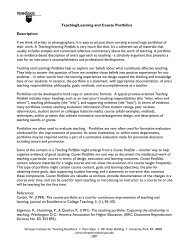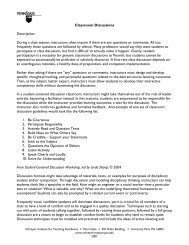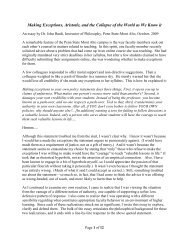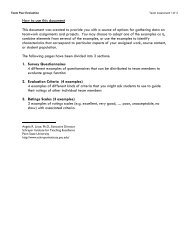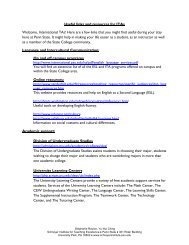Form for Providing Feedback on a Classroom Teaching Observation ...
Form for Providing Feedback on a Classroom Teaching Observation ...
Form for Providing Feedback on a Classroom Teaching Observation ...
Create successful ePaper yourself
Turn your PDF publications into a flip-book with our unique Google optimized e-Paper software.
<str<strong>on</strong>g>Form</str<strong>on</strong>g> <str<strong>on</strong>g>for</str<strong>on</strong>g> <str<strong>on</strong>g>Providing</str<strong>on</strong>g> <str<strong>on</strong>g>Feedback</str<strong>on</strong>g> <strong>on</strong> a<br />
<strong>Classroom</strong> <strong>Teaching</strong> Observati<strong>on</strong> or Microteaching Dem<strong>on</strong>strati<strong>on</strong><br />
Please provide as much in<str<strong>on</strong>g>for</str<strong>on</strong>g>mati<strong>on</strong> as you can to give the instructor feedback <strong>on</strong> his/her ef<str<strong>on</strong>g>for</str<strong>on</strong>g>ts to engage<br />
course participants in meaningful learning activities.<br />
1. What kinds of teaching methods or instructi<strong>on</strong>al strategies is the instructor using? (Check all that<br />
apply, and comment as relevant.)<br />
Lecturing strategies:<br />
Comments <str<strong>on</strong>g>for</str<strong>on</strong>g> instructor?<br />
___ Announcements<br />
___________________________________<br />
___ Summarizing familiar in<str<strong>on</strong>g>for</str<strong>on</strong>g>mati<strong>on</strong> ___________________________________<br />
___ Introducing new in<str<strong>on</strong>g>for</str<strong>on</strong>g>mati<strong>on</strong><br />
___________________________________<br />
___ Relating new in<str<strong>on</strong>g>for</str<strong>on</strong>g>mati<strong>on</strong> to old ___________________________________<br />
___ Explaining/dem<strong>on</strong>strating c<strong>on</strong>cepts ___________________________________<br />
___ <str<strong>on</strong>g>Providing</str<strong>on</strong>g> analogies<br />
___________________________________<br />
___ Relating stories/anecdotes<br />
___________________________________<br />
___ Making jokes<br />
___________________________________<br />
___ Other: _________________________ ___________________________________<br />
Discussi<strong>on</strong> strategies:<br />
Comments <str<strong>on</strong>g>for</str<strong>on</strong>g> instructor?<br />
___ Inviting questi<strong>on</strong>s from students ___________________________________<br />
___ Redirecting obvious or easy questi<strong>on</strong>s ___________________________________<br />
___ Pausing to give students time to think ___________________________________<br />
___ Asking a fact-related questi<strong>on</strong><br />
___________________________________<br />
___ Asking a higher-order thinking questi<strong>on</strong> ___________________________________<br />
(e.g., “Why?” or “What if?”)<br />
___ Inviting student examples/experiences ___________________________________<br />
___ Praising/acknowledging a resp<strong>on</strong>se ___________________________________<br />
___ Helping a student resp<strong>on</strong>d<br />
___________________________________<br />
___ Correcting misguided resp<strong>on</strong>ses ___________________________________<br />
___ Other: __________________________ ___________________________________<br />
Collaborative/problem-solving strategies: Comments <str<strong>on</strong>g>for</str<strong>on</strong>g> instructor?<br />
___ C<strong>on</strong>ducting think/pair/share exercise ___________________________________<br />
___ Students work problems <strong>on</strong> board ___________________________________<br />
___ Students work problems in groups ___________________________________<br />
___ Students work <strong>on</strong> projects in groups ___________________________________<br />
___ Instructor actively m<strong>on</strong>itors groups ___________________________________<br />
(asking questi<strong>on</strong>s, offering help, etc.)<br />
___ Instructor passively m<strong>on</strong>itors groups ___________________________________<br />
(listens, speaks <strong>on</strong>ly if spoken to)<br />
___ Groups role play, compete, etc. ___________________________________<br />
___ Other: __________________________ ___________________________________<br />
R. Neill Johns<strong>on</strong><br />
Schreyer Institute <str<strong>on</strong>g>for</str<strong>on</strong>g> <strong>Teaching</strong> Excellence • Penn State • 301 Rider Building University Park, PA 16802<br />
www.schreyerinstitute.psu.edu • 2007
2. How would you describe the instructor’s use of the board, the overhead projector, PowerPoint<br />
slides, and/or any other use of instructi<strong>on</strong>al technology to bring additi<strong>on</strong>al audio-visual (or other<br />
sensory) dimensi<strong>on</strong>s to learning?<br />
3. How would you describe the instructor’s oral communicati<strong>on</strong> with students? What indicates that<br />
the instructor is verbally reaching and resp<strong>on</strong>ding to students effectively?<br />
4. How would you describe the instructor’s body language toward students? Which gestures,<br />
movements, facial expressi<strong>on</strong>s, and other physical resp<strong>on</strong>ses make the instructor more friendly and<br />
accessible? Which <strong>on</strong>es, if any, make him/her less friendly and accessible?<br />
5. What student behaviors not menti<strong>on</strong>ed previously did you witness in this sessi<strong>on</strong>? Which of these<br />
behaviors c<strong>on</strong>tributed to a good learning envir<strong>on</strong>ment? Which were distracting or disruptive?<br />
6. What other comments do you have that might be helpful to the instructor (e.g., regarding the<br />
handling of sessi<strong>on</strong> c<strong>on</strong>tent, extenuating circumstances, etc.)?<br />
7. How would you rate the overall effectiveness of the teaching in this sessi<strong>on</strong> <strong>on</strong> the following scale,<br />
with “5” representing “most highly effective”? (Please circle <strong>on</strong>e number.)<br />
1 2 3 4 5<br />
Adapted from:<br />
Harris, Arlene H. and M<strong>on</strong>ica Farmer Cox. “Developing an Observati<strong>on</strong> System to<br />
Capture Instructi<strong>on</strong>al Differences in Engineering <strong>Classroom</strong>s.” Journal of Engineering<br />
Educati<strong>on</strong> 92 (2003): 329-336.<br />
R. Neill Johns<strong>on</strong><br />
Schreyer Institute <str<strong>on</strong>g>for</str<strong>on</strong>g> <strong>Teaching</strong> Excellence • Penn State • 301 Rider Building University Park, PA 16802<br />
www.schreyerinstitute.psu.edu • 2007


